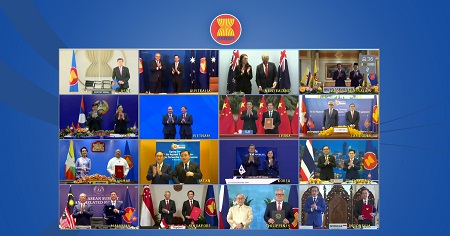Leaders of ASEAN Member States, Australia, China, Japan, Republic of Korea and New Zealand signed the Regional Comprehensive Economic Partnership (RCEP) Agreement. The RCEP marks ASEAN’s biggest free trade pact to date, covering a market of 2.2 billion people with a combined size of US$26.2 trillion or 30% of the world’s GDP.
The signing of the RCEP Agreement is a historic event as it underpins ASEAN’s role in leading a multilateral trade agreement of this magnitude, despite global and regional challenges and eight years of negotiations, according to Dato Lim Jock Hoi, Secretary-General of ASEAN. Also, the RCEP is expected to give a much-needed boost for a swift and robust recovery for businesses and peoples in the region particularly during the current COVID-19 pandemic crisis.
The deal will improve market access with tariffs and quotas eliminated in over 65% of goods traded and make business predictable with common rules of origin and transparent regulations, upon entry into force. This will encourage firms to invest more in the ASEAN region, including building supply chains and services, and to generate jobs.

The Agreement has 20 Chapters, 17 Annexes and 54 schedules of commitments covering market access, rules and disciplines, and economic and technical cooperation.
Negotiations of RCEP, which started in 2013, were led by Iman Pambagyo, Director-General of Indonesia’s Ministry of Trade, and with support provided by the ASEAN Secretariat. The virtual signing by ministers took place following the conclusion of the 4th RCEP Summit on 15 November 2020.
The virtual 15th East Asia Summit was held over the weekend and was attended by representatives from all ten ASEAN members, China, India, Russia, Japan, South Korea, Australia, New Zealand and the United States. The summit was chaired by Prime Minister of Vietnam Nguyen Xuan Phuc in his capacity as chair of the ASEAN.














